If you are taking a cruise you may be wondering how cruise ships plan for and avoid bad weather.
I’ve been on many cruises where these methods have been used, during this post we will look at the cruise line options for avoiding bad weather.
Do Cruise Ships Avoid Bad Weather?
Cruise ships avoid bad weather by changing their itineraries either in advance or at the last minute.
A cruise ship may return to port ahead of schedule or cancel the cruise completely.
Cruise ships will often leave a port earlier, arrive late, or change the sailing itinerary to avoid a storm or hurricane.
Due to the fact that the weather is ever-changing, the cruise line has to be constantly monitoring the situation to decide on the best approach to take.
Avoiding Bad Weather #1: Change Itinerary Ahead of Time
If a cruise line knows that there is likely to be bad weather in a certain area they are usually able to change the itinerary ahead of time.
Weather forecasting is better than ever, and the cruise lines are constantly checking on what the weather will be like on their planned itinerary.
How Far in Advance Could This Happen?
It could be as early as 5 days or a week before the cruise that the itinerary changes.
This usually only happens due to things like hurricanes – but could in theory happen for any bad weather.
Generally speaking, the worse the weather is expected to be the further in advance the cruise lines will start making adjustments to their itineraries.
All guests already onboard the cruise will receive information in their cabin from the cruise line about the new itinerary and the reasons for the change.
This will be in the form of a letter or email if it is prior to the sailing, but on occasion, guests won’t receive this and will only find out once onboard.
The cruise line will do everything that they can to let the guests know but with many already having started their journeys at this point it can be difficult.
This is providing that the cruise itinerary still starts and ends in the same port.
If there was a dramatic itinerary change – such as it starting in another port the cruise line would do their best to call each passenger or the travel agent would do this.
In reality, this very rarely happens and cruise lines will do almost anything to avoid changes to the embarkation or disembarkation ports.
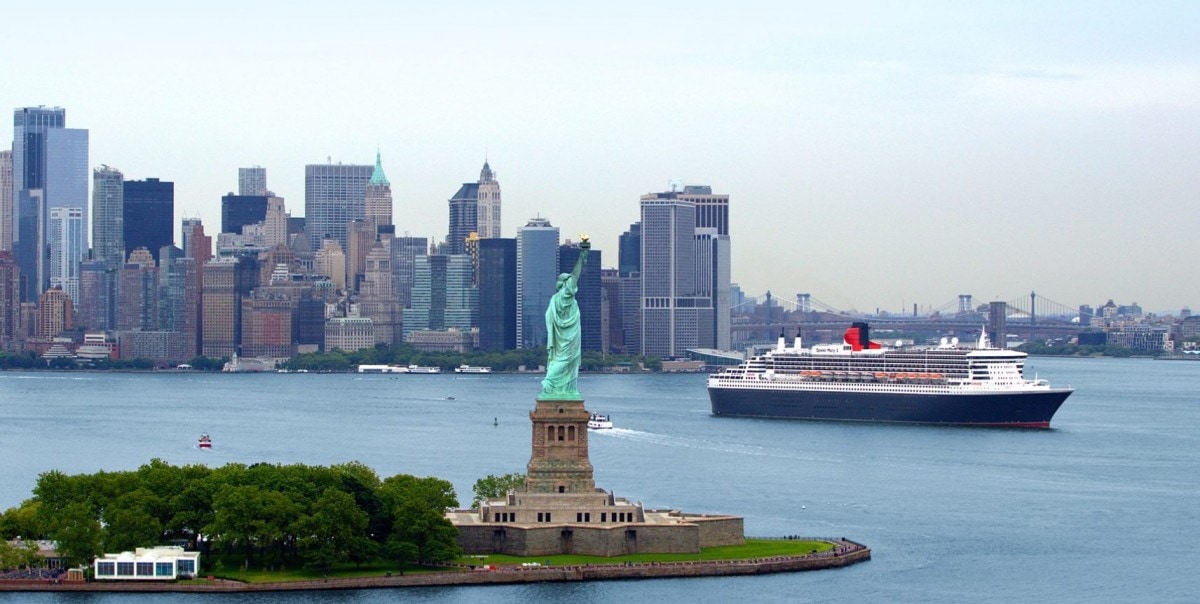
Are You Entitled to Compensation?
Guests are not automatically entitled to any compensation for itinerary changes.
It may be possible to reclaim something from your travel insurance provider, depending on the policy you have bought.
To find out more about compensation, including when you’ll be given a full refund, check out this post:
Do You Get Compensation For Missed Cruise Ports?
Avoiding Bad Weather #2: Leave Port Earlier or Later
One of the most common things that happens in bad weather is that a cruise ship may leave a port earlier or later to try and avoid some of the worst of the storm.
This has happened to me on a couple of occasions. We have been told the day before that the next day we would be leaving earlier than scheduled to miss some bad weather.
How Far in Advance Could This Happen?
If this does happen you’ll be told in advance.
A cruise ship wouldn’t be able to change the “all onboard ” time once the guests have disembarked because if they did they’d be risking leaving a number of guests on land.
Cruise lines do not want to leave guests behind!
Moving the sail away time earlier is quite common and could happen for a variety of reasons.
The most common is when there is expected to be a storm the cruise ship may leave early to try and outrun the bad weather.
When I cruised on P&O’s Ventura, the captain delayed leaving Lisbon until late at night, to avoid a storm in the Bay of Biscay. Find out more about that stormy cruise here:
It can also be difficult for cruise ships to manoeuvre certain cruise ports and in situations like this – it may be easier for the ship to be at sea when the bad weather hits.
How Much Earlier Could The Ship Leave?
There isn’t really a minimum amount of time that a cruise ship has to spend in port.
Generally speaking, most cruise ships will be docked for a full day, for example, 9 am – 6 pm – but I have been on cruises where we have arrived at 7 am and left at 11 am.
Find out more about how long ships stay in port in this article:
How Long Do Cruise Ships Stay In Port? (My Experiences of Short Stays to Multi-Day Stays)
I took a cruise with Celestyal Cruises around the Greek islands where we visited 7 cruise ports in 4 days. We had two ports most days and that is why we left early on occasion.
In reality, if the all aboard time is moved earlier to avoid bad weather it’s likely to be only 2 or 3 hours and still leave you with at least 6 or so hours to explore the port.
Avoiding Bad Weather #3: Change Sailing Route
It’s not uncommon for cruise ships to change the route on which they are sailing if they are not changing the destinations or the timings.
If a storm is to be in a certain area, cruise ships may take a slightly different itinerary to avoid the worst of the storm.
It isn’t possible to avoid areas like the Bay of Biscay completely, but there are routes which may avoid the worst of bad weather.
To learn more about the Bay of Biscay and to find out if you’re likely to experience seasickness there, check out this post:
Cruising Through The Bay Of Biscay: What to Expect
When I sailed onboard P&O’s Arvia, the captain tried sailing very fast to avoid a storm in the Bay of Biscay.
Unfortunately, there was then a medical emergency onboard and he had to make an unscheduled stop at A Caruna on the Northern edge of Spain ( above Portugal.)
Despite travelling at full speed through the night to avoid the storm – we still arrived later than scheduled in Southampton at the end of the cruise.
Find out all about my cruise on Arvia here:
Will Passengers Notice?
If the cruise route is changed, it will probably go unnoticed by the passengers onboard the cruise.
I have many friends who look at cruise maps to see the current locations of cruise ships, they’ll often say things like “Oooo look! The MSC Meraviglia is taking a funny route…”
I have to admit I don’t really know the standard routes for cruise ships to take but I am assured that sometimes cruise ships will do odd things to avoid bad weather.
Making a change to the scheduled itinerary may mean taking a slightly longer route but travelling much faster.
This may affect how the movement of the ship is felt but generally speaking, a change of route isn’t anything for the passengers to worry about.
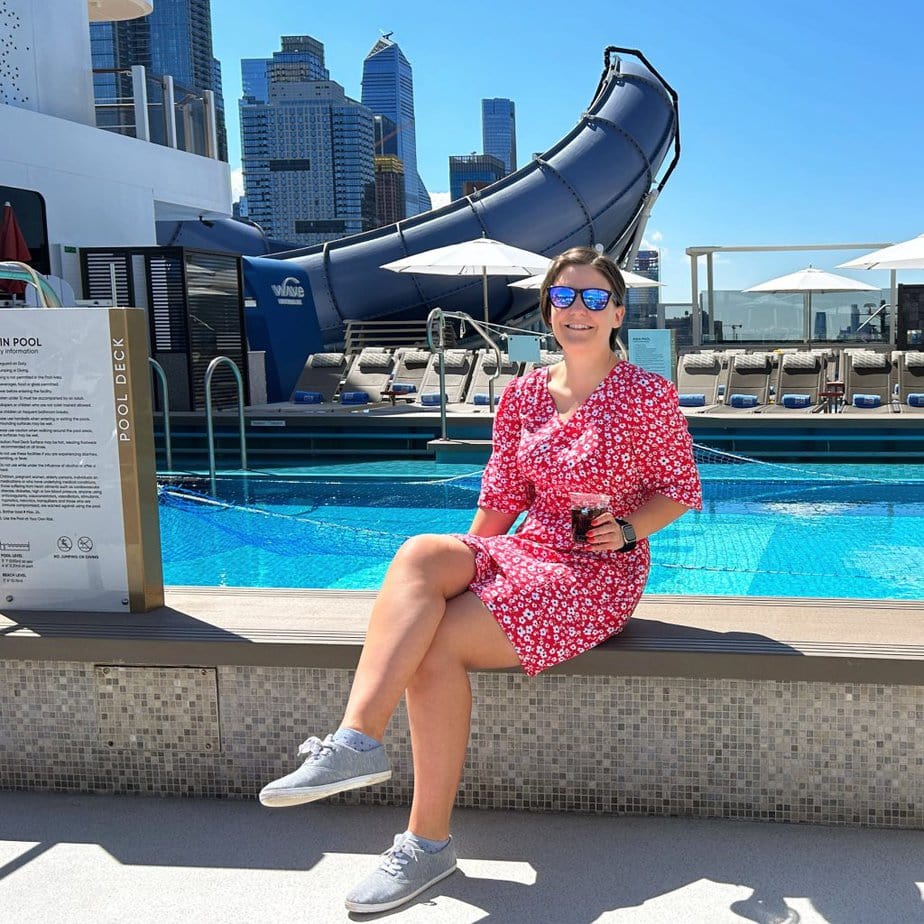
In a worst-case scenario, a few guests may suffer from seasickness.
Cruise ships do have medical supplies and medical teams on board who will look after you if this does happen. You would be sensible to pack seasickness tablets though, just in case.
It may surprise you to know I do sometimes get seasick. Find out what I do to avoid that happening here:
13 Actionable Tips to Prevent and Treat Seasickness on a Cruise
Avoiding Bad Weather #4: Ending The Cruise Early
In extreme cases, the cruise itself may come to an end earlier than planned.
This usually only happens as the result of hurricanes but may also happen if too many guests onboard get sick with something like Norovirus.
Cutting a cruise short means that cruise ships can avoid bad weather by simply not being at sea at the time of the storm.
If this happens there are usually two options.
- The first is that the cruise ship will return to the disembarkation port a day or two earlier but will remain there for guests to stay on. The cruise ship will act as a hotel in this circumstance and guests will be able to eat, drink and take part in the onboard entertainment as normal.
- The second option is that guests are asked to disembark the cruise ship earlier than scheduled. The cruise line may have to find flights or hotels for guests in this circumstance.
If a cruise is cut short the cruise line will usually refund this portion of the cruise to passengers but this usually only happens if guests are asked to disembark.
Certain travel insurance policies may provide cash lump sums for missed cruise ports but this does depend on the individual travel insurance policy.
Find out more about why you need travel insurance, and how to find a decent policy, read my step-by-step guide below:
Cruise Travel Insurance – Why You Need it and How to Get It: (Step by Step Illustrated Guide)
When something like this happens the cruise line will usually let the passengers know as soon as possible. This isn’t usually done in advance and will most likely be a last-minute decision by the cruise line.
When a decision like this is made onboard it’ll usually be announced over the tannoy and the daily schedule which is delivered to your cabin each night will be amended to reflect this change.
Avoiding Bad Weather #5: Changing The Itinerary Last Minute
In some circumstances, the cruise itinerary can be changed last minute. This could be as little as an hour or two before the cruise ship is set to dock.
A last-minute change in itinerary is particularly common in cruise ports where guests have to use a Tender Boat to get to land.
Cruise ships can’t risk operating tender boats in bad weather so if a port is only accessible by tender it’s more likely that the port will be skipped.
To learn more about cruise ship tendering, including which boats they usually use, check out this post:
Cruise Lines May Use Substitute Ports
Cruise ports can be missed or amended with little to no warning. In most circumstances, the cruise line will try to have a substitute port ready that they can visit – but this isn’t always possible.
If there isn’t anywhere for a cruise ship to go the port day may become a sea day, and the cruise lines are prepared for eventualities like this.
When I sailed with the luxury cruise line Azamara, we had to cancel our stop in Corsica because of bad weather in the Mediterranean.
They managed to secure a berth in Genoa instead. Find out all about that luxury cruise, and what I thought of it here:
What Happens to Excursions if Your Cruise Port is Cancelled?
If your itinerary is changed any excursions booked through the cruise line will be automatically refunded to your onboard account.
Any excursions booked independently will not be refunded. Passengers would have to talk to the independent provider with whom they booked the excursions to get a refund.
This security is one of the main reasons why some people prefer to take cruise line excursions.
I personally usually avoid cruise line excursions because of the cost associated with them – but for peace of mind, they are definitely the most reliable option.
Before You Go
If you are worried about feeling seasick on a cruise, it makes sense to choose your cabin position carefully. Find out all about that in the article below:
What is The Best Cabin Location on a Cruise For Avoiding Seasickness? (I’ve Tried Them All!)
Find out what it is sensible to pack for your cruise (in the unlikely event of you feeling unwell) here:
Staying Healthy When You Cruise, Avoiding Seasickness – Medications and First Aid Items to Pack
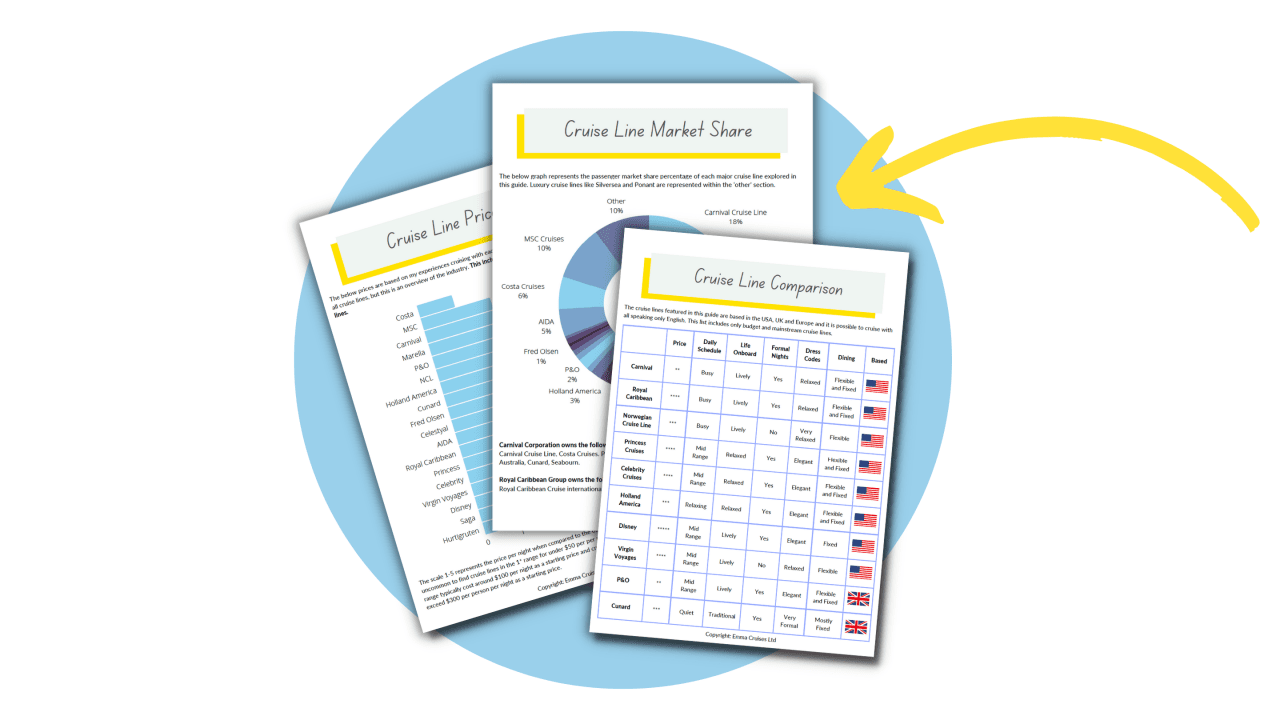
Free Insiders Cruise Line Guide
Ever wondered how the mainstream cruise lines compare? Cruise lines won’t tell you this, but I will.
This FREE guide shows you everything you need to know to find your perfect cruise line.
Whenever I take a cruise I order a print of my trip. It uses the real satellite data from the cruise and is always a great conversation starter!
I'm building an impressive collection...
Code EMMACRUISES will get you 10% off
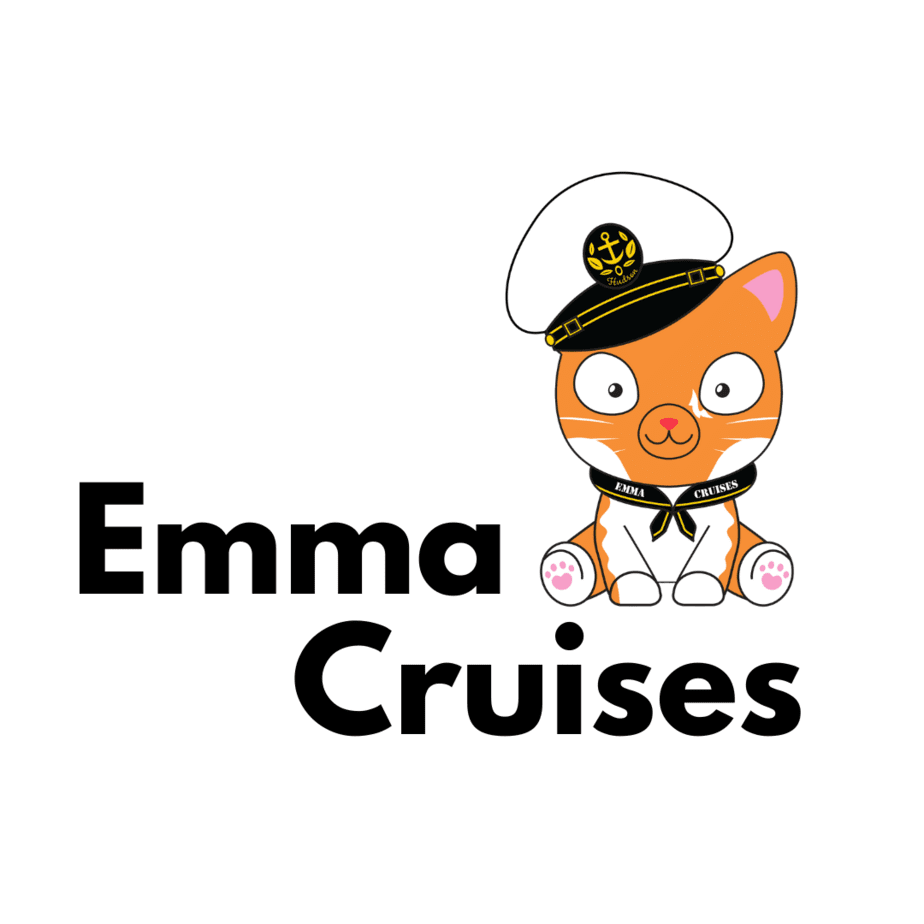
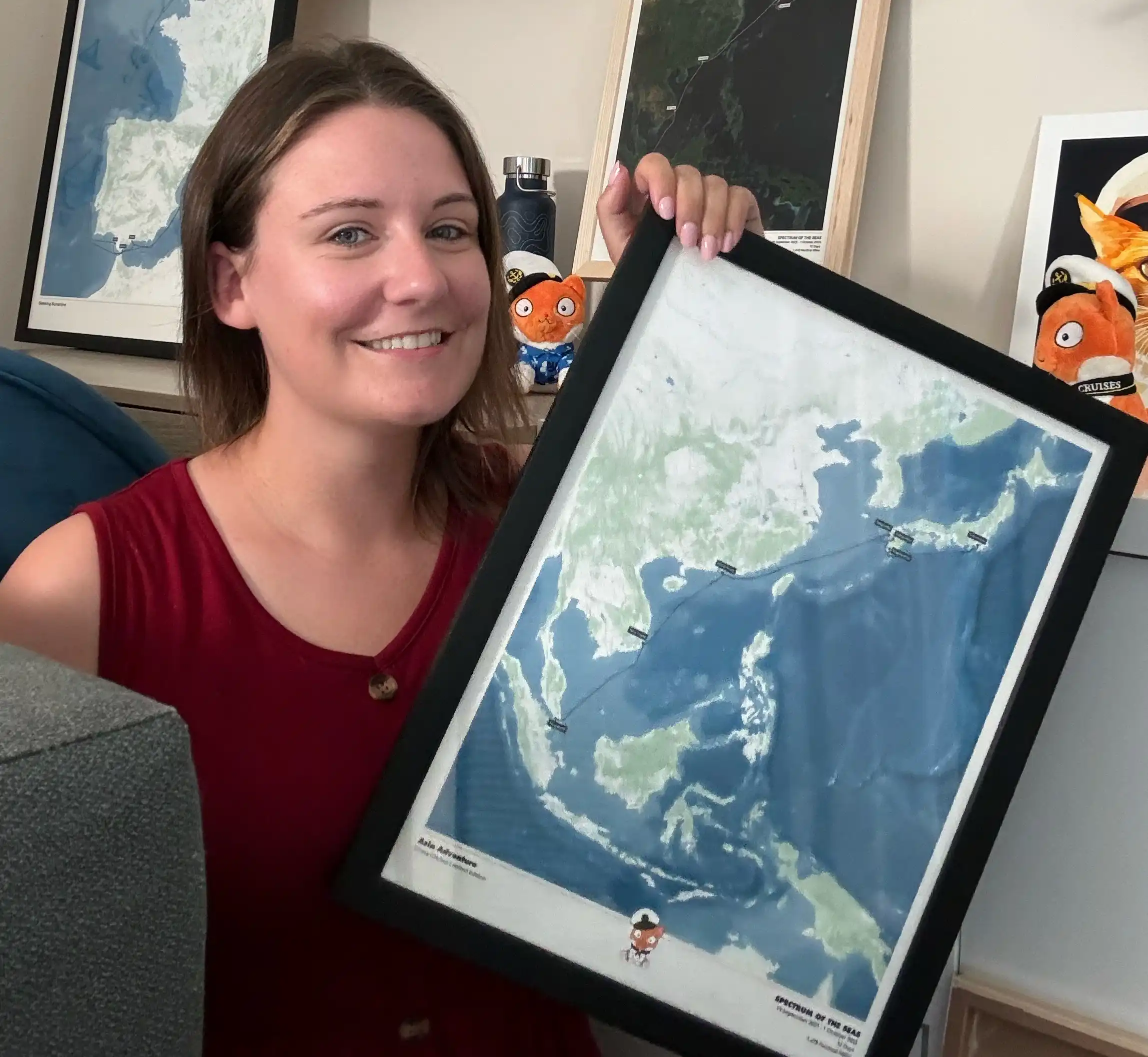
How Long Can a Cruise Ship Stay Out At Sea For? – Emma Cruises
Tuesday 27th of October 2020
[…] Average speed of the sailing – Cruise ships can burn through over one thousand gallons of fuel every hour when sailing. Generally speaking the faster a cruise ship sails the most fuel it has to use to do that. If a cruise ship is travelling fast to avoid a storm or to reach a destination in a short period of time it’ll use more fuel than if travelling slowly. To learn more about how, and why, a cruise ship would sail at an increased speed to avoid bad weather, check out this article: 5 Ways Cruise Ships Avoid Bad Weather. […]